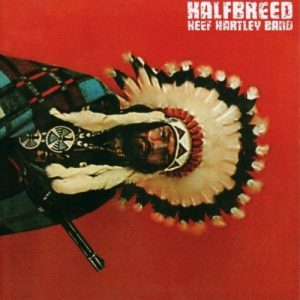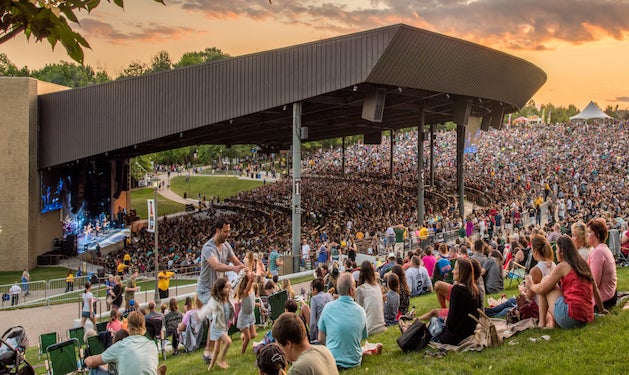The Keef Hartley Band is another of the bands who, through no fault of their own, failed to get the fame and recognition others received from their Woodstock appearance. It’s a shame, really, because this band was really good.
Day Two, Performer 5: Keef Hartley Band
Performed Saturday afternoon, August 16, 4:45–5:30 pm

Keef Hartley on drums, Miller Anderson on guitar, Henry Lowther on trumpet, and Jimmy Jewell on saxophone, on stage at Woodstock (not shown, Gary Thain on bass). Photos © Jason Lauré.
Keef Hartley Band Members
- Keef Hartley: drums
- Miller Anderson: guitar, vocals
- Jimmy Jewell: saxophone
- Henry Lowther: trumpet, violin
- Gary Thain: bass
Keef Hartley Band Woodstock Setlist
- Spanish Fly
- Think it Over
- Too Much Thinking
- Believe in You
- Medley: Sinnin’ For You/Leavin’ Trunk/The Halfbreed/Just to Cry/Sinnin’ For You
Born in 1944 in the northern English city of Preston, a teenage Keef Hartley fell in love with the sounds of early English rock groups such as The Shadows, as well as American bands The Ventures and drummers like Sandy Nelson (who had an instrumental hit with “Let There Be Drums”). He formally began his musical career in 1962 with a brief tenure as the replacement drummer for Ringo Starr in the legendary Liverpool group, Rory Storm and the Hurricanes. Finding their music unfulfilling, Keef swapped drumming positions with Ian Broad of Freddie Starr and The Midnighters one evening while the two groups were sharing a bill. His time with Freddie Starr proved invaluable, as his drumming chops were honed and refined over the course of many long hours spent playing, in a similar fashion to the apprenticeship served by The Beatles, in the clubs of Hamburg, Germany.
After a successful stand with Freddie Starr, Hartley migrated to London, initially joining a pop group known as The Artwoods. Finding additional employment as a session drummer, Hartley eventually caught the attention of John Mayall, leader of the legendary blues ensemble The Bluesbreakers. Hartley’s drumming was first heard on the 1967 John Mayall solo album Blues Alone, after which Hartley, as an official Bluesbreaker, played on the albums Crusade and Diary of a Band.
Hartley left Mayall amicably in 1968, forming the loose aggregation of musicians known as Keef Hartley Band. The band, which combined elements of blues, jazz, and rock, was centered around the guitar playing and songwriting of Miller Anderson, whose prodigious talent was at least equal to any of the better-known guitar slingers of the day. Holding down the bass position was New Zealander Gary Thain, and the initial Keef Hartley Band lineup was completed by a horn section consisting of London jazz trumpeters Henry Lowther and Harry Beckett and respected session saxophonists Lyn Dobson and Chris Mercer.
This lineup recorded their debut album, Halfbreed, in late 1968 (the cover of which featured Hartley in the garb of a Native American tribal chief). The album (which opens with a jokey “phone call” in which John Mayall “fires” Hartley) was packed with hard-driving, bluesy rockers infused with upfront brass arrangements. Released in early 1969, the band (now pared down to a five-piece lineup after the departures of Harry Beckett, Lyn Dobson, and Chris Mercer; Jimmy Jewell would take saxophone duties for The Hartley Band’s touring lineup) toured relentlessly behind Halfbreed, including their first trip to the United States in August 1969. After deplaning in New York City, the band was driven by limousine to their first American date, the Woodstock Music and Art Fair.

Halfbreed (Deram, 1969),
was released six months before the Woodstock festival.
The band was still relatively unknown when they played Woodstock, But their spirited blend of horn-driven blues rock made them a great choice to get the crowd pumped up for the festival’s Saturday night lineup. If the idea of playing to such a large crowd didn’t make the members of Keef Hartley Band nervous, the band that they were originally slated to follow certainly did. As Miller Anderson recalled, “ we were standing at the side of the stage waiting to play, when the guy went up to announce the band that was on before us—‘Ladies and gentlemen, a new band from San Francisco, Santana!’ They [started playing], and they were FANTASTIC! And we just stood on the side and said ‘oh Jesus, we’re on next!’” Fortunately, the band members’ nerves were allayed somewhat when John Sebastian took the stage after Santana, playing an acoustic set that cooled down the crowd, who were on the verge of being overheated by the hot Latin rock.
Introduced by Chip Monck, Hartley and his cohorts opened the set with the mid-tempo instrumental “Spanish Fly,” showcasing both Miller Anderson’s outstanding guitar playing and the band’s punchy horn arrangements. An even funkier groove followed with “Think It Over,” which boasted a killer riff driven by Hartley’s drums and Anderson’s guitar and shouted vocals. The tempo was taken down a notch for the bluesy ballad “Too Much Thinking” and the folky “Believe In You” (a song that would be released in October 1969 on the group’s second album The Battle Of North West Six). The set wrapped up with a powerful “Sinnin’ For You” from Halfbreed, which incorporated elements of Sleepy John Estes’ “Leavin’ Trunk,” “The Halfbreed,” and “Just To Cry” all taken from their debut album.
Unfortunately, due to a dispute with the group’s manager (who wanted $2,000 in cash upfront to sign a release), Michael Wadleigh’s film crew was unable to film any of Keef Hartley Band’s set. As a result, there was no real reason to put him on the Woodstock soundtrack album released the following year, making their performance one of Woodstock’s legendary missed opportunities. Such exposure would doubtless have prevented the slide into obscurity that eventually engulfed the group. While the band continued to tour and release albums, more poor choices (Hartley declined an invite to promote their single “Roundabout” on the U.K.’s top music program Top Of The Pops saying that “we’re not that kind of band”), and friction with their record company Decca Records hampered whatever forward momentum they had going for them.

The Battle of North West Six (Deram, 1970), The Time is Near (Deram, 1970), and Overdog (Deram, 1971).
Hartley also released several solo albums.
Trumpeter Henry Lowther left Keef Hartley Band in 1970 and continues to work with musicians such as Jack Bruce, Bryan Ferry, John Mayall, Van Morrison, Elton John, Charlie Watts, and the Berlin Contemporary Jazz Orchestra. Saxophonist Jimmy Jewell also left in 1970 and, after working with jazz groups in Chicago, returned to England where he continues to play today. Bassist Gary Thain left in 1972 to join Uriah Heep, a stint that ended in 1974 when he was seriously injured after being electrocuted onstage. He would tragically die of a heroin overdose in 1975, at the age of 27. By early 1973, Keef Hartley Band was dissolved, with Miller Anderson going on to work with the likes of Blood, Sweat & Tears, T Rex, and a re-formed Spencer Davis Group. He continues playing today.
Also in 1973, Keef Hartley recorded his first and only solo album, Lancashire Hustler. While the album did provide a full dose of the sort of blues- jazz and rock that Hartley was known for, it was not a big seller. Hartley returned to Preston, and gave up his full-time musical ambitions to work in construction, playing in local musical outfits when the mood struck him. His autobiography, Halfbreed (A Rock And Roll Journey That Happened Against All The Odds) was published in 2007. By that time, Hartley’s health was in serious decline, and he died at Royal Preston Hospital in Preston on November 26, 2011, at the age of 67.
—Wade Lawrence & Scott Parker
